Although originally designed to measure atmospheric water vapor and temperature profiles for weather forecasting, data from the Atmospheric Infrared Sounder (AIRS) instrument on NASA’s Aqua spacecraft are now also being used by scientists to observe atmospheric carbon dioxide. Scientists from NASA; the National Oceanic and Atmospheric Administration; the European Center for Medium-Range Weather Forecasts; the University of Maryland, Baltimore County; Princeton University, Princeton, New Jersey; and, the California Institute of Technology (Caltech), Pasadena, Calif., are using several methods to measure the concentration of carbon dioxide in the mid-troposphere (about eight kilometers, or five miles, above the Earth’s surface).
This global map of mid-troposphere carbon dioxide shows that despite the high degree of mixing that occurs with carbon dioxide, the regional patterns of atmospheric sources and sinks are still apparent in mid-troposphere carbon dioxide concentrations. Climate modelers are currently using AIRS data to study the global distribution and transport of carbon dioxide.
For more information, visit the AIRS Project Web Site.Image credit: NASA/JPL
1 min read


























